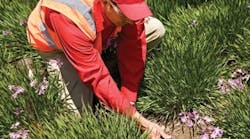Commercial real estate industry leaders who operate large portfolios, corporate campuses, or even single assets must examine all aspects of their budgets to find ways to maximize value while achieving the highest standards of property performance.
Landscape-maintenance programs can help with this – they create value, improve the environment, and produce impressive results for the bottom line. One area of potential high impact and significant ROI is a landscape plan that’s grounded in water efficiency.
On topic: A LEED-Inspired Model for Landscapes
For owners and managers in arid regions, water conservation is a fact of life. But, for some owners and managers, water may not be perceived as a precious resource simply because it seems to be plentiful. Even though water is relatively inexpensive, it is a limited natural resource.
As the population increases, the earth’s available fresh water remains constant; thus, as demand increases, so will the price. Adopting a smart water-management program now is a critical part of operating a building at peak efficiency at all times – not just when drought conditions or irrigation restrictions exist.
Cutting costs through sustainable practices makes financial sense as well. Companies throughout the country are learning that landscape management can enhance the bottom line in a number of ways, including making the grounds more aesthetically pleasing and more sustainable, which plays a role in improved corporate citizenship, employee satisfaction, and tenant retention.
Related: LEED Certification Tips: Water Efficiency
Water-Conservation Pointers
- Switch from overhead irrigation to a more efficient drip system with the installation of smart, weather-based controllers that measure precipitation, solar radiation, and wind, and adjust systems automatically as needed.
- Maintain landscapes that are in harmony with the environment by reducing green waste, nurturing healthy soils, creating wildlife habitats, and reducing stormwater runoff.
- Analyze water-usage trends and develop a water-management plan to ensure that irrigation systems operate efficiently, irrigation runoff is reduced, and reclaimed water is used.
- Practice hydro-zoning or grouping plants with similar water requirements on the same irrigation valve to reduce overwatering.
- Install flowering perennial plants to provide a sustainable, cost-effective replacement for seasonal color changes.
- Implement a rotation schedule for water features so that fewer operate at one time, reducing energy costs.
- Retrofit the landscape with sustainable, water-efficient landscapes and native, drought-tolerant plant materials to reduce the use of natural resources and decrease the amount of maintenance required.
- Optimize the placement and health of trees around your buildings to increase shade and reduce energy costs.
- Maintain the landscape in a natural fashion by using pruning techniques that highlight the individuality of each plant.
- Explore public programs offered by water districts, cities, or other entities that provide rebates or credits for upgrades on controllers, efficient irrigation, drip conversions, or rain shutoff sensors.
An example of a smart water-conservation program is at Cisco Systems in San Jose, CA, which, over the past decade, has adopted a more ecologically friendly landscape program and, at the same time, reduced operating costs for its landscaping.
Cisco’s landscape-management plan focuses on three components:
1. Horticultural improvements.
Initially, the landscaping company working with Cisco determined the water consumption and maintenance costs required to sustain the current level of landscape, identified plants that required the most water, and determined fertilizer needs – all of which revealed opportunities for improvement.
The landscape program encompassed a plant-density reduction plan that resulted in the removal of some plants that required significant amounts of water. Plants that required watering 5 days-a-week were replaced with shrubs requiring only 2 days of irrigation a week.
2. Reducing water consumption.
Water-conserving drip irrigation systems were systematically installed, and all 48 buildings on the campus were retrofitted with smart, weather-based controllers that lower irrigation water usage by 24 percent a year on average. In California alone, Cisco saves more than 81 million gallons of water from its water-conservation efforts as reported in its 2007 Corporate Citizenship Report.
3. Sending less waste to landfills.
Bagging and dumping grass cuttings is labor intensive (not to mention the water needed to maintain a vivid green appearance and the fuel used to cut and transport them); recycling tree clippings and composting onsite reduces landfill waste.
Turf-reduction programs on parts of Cisco’s 98-acre campus helped produce less green waste. In the turf areas that remained untouched, using specially designed equipment to mulch the grass clippings onsite resulted in water and fertilizer reductions.
The strategic landscape program at Cisco serves as a nationwide model for integrating landscape services into a building’s operating plan. Procedures and processes have been tested for more than a decade, resulting in a smoothly running program.
Implementing Green Leases: An Exclusive Interview with Kathleen Hogan
Perhaps because the San Francisco Bay Area has long focused on issues concerning the environment and sustainability, it features a number of additional examples of smart water-management programs that are yielding positive results.
10 Smart Irrigation Tips
Irrigation can account for more than 50 percent of a facility’s water consumption. Here are some ways to water smarter:
- Water early in the morning, right before dawn. It reduces losses to wind and evaporation.
- Water only when needed.
- Adjust sprinklers to avoid waste and ensure uniform distribution.
- Test the spray patterns of sprinkler systems; check for clogged lines and mixed nozzle sizes of sprinkler heads, and be sure to repair leaks.
- Use drip irrigation for ornamental shrubs to reduce water usage.
- Install rain shutoff devices or in-ground moisture sensors.
- Set lawnmower blades higher to increase ground shade and water retention in soil.
- Mulch around shrubs and planters to reduce evaporation and cut down on weeds.
- Use a broom vs. a hose to clean driveways or sidewalks.
- Use a hose with an automatic shutoff nozzle.
One landscaping company helped institute a water-management program for Equity Office Properties’ operations throughout the Bay Area and Northern California. This large property management company serves multi-tenant retail, commercial, and industrial clients.
It has incorporated water conservation and sustainability programs into its budgeting process, and holds educational seminars with property managers on landscape water conservation. The company has combined sustainability and water conservation in its marketing and leasing approaches, too.
Between 2007 and 2008, Equity and its property managers worked diligently with its landscape provider to save approximately $90,000 in water costs on landscapes in its large building portfolio.
To accomplish this, 70 ET (evapotranspiration) irrigation controllers were installed at 90 buildings in the Bay Area. The company also installed subsurface drip irrigation on 86 stations and converted nearly 163,000 square feet of high-input plants to sustainable native plants.
Lastly, a water-conservation program implemented at Bayshore Technology Park in Redwood City, CA, over the past several years allowed the owner, Harvest Properties, to achieve measurable aesthetic and financial results.
This was accomplished by installing nine ET irrigation controllers, practicing hydro-zoning, converting onsite tree trimmings into natural mulch, converting shallow-rooted groundcover into drought-tolerant shrubs with a drip vs. a spray irrigation system, and reducing turf areas under canopy trees.
The investment and commitment to water conservation and site sustainability have allowed Harvest Properties to reduce landscape water costs by 29 percent, and has prepared the site for conversion to use reclaimed water in the future.
The result of smart landscape-management programs: owners and managers maximizing every dollar spent. Water management must be done in a way that makes sense for companies; it must be efficient, it must be collaborative, it must be simple, and it requires participation by all.
It might even involve integration of the landscape team into a building’s overall green planning initiatives. The landscape is one of the primary areas companies can look at to achieve LEED standards.
Existing buildings that are undergoing LEED certification must score a minimum of 34 points out of a total of 92. With 14 points potentially coming from the landscape, it’s just plain smart to incorporate advanced water technologies, sustainable plant material, and renewable resources.
These efforts include landscape retrofits, new technologies to reduce water usage, and recycling tree clippings and composting onsite to reduce landfill waste.
By working directly with building owners who are designing new buildings, a landscape maintenance representative can recommend a plant palette that doesn’t increase water costs. If you’re seeking LEED certification for your buildings, tapping into deep horticultural and maintenance experience can provide a plan in terms of how many points could be earned in the landscape category.
The plan can be laid out so you know what perennial plants should be used, how you can qualify for waste reduction, how many points you could earn by converting irrigation to drip irrigation, and which trees to plant to generate savings in heating and cooling costs.
Find out how smart building technology is changing facilities management.
These tips and examples show that positive results occur when building owners and managers treat landscape as an asset and practice sustainable principles, such as water and waste reduction.
The value of the landscaped asset increases, spending on maintenance decreases, less water is used, and more environmentally-friendly processes are integrated into standard operations. Ultimately, a smart water-management program can help a building run more efficiently, and that’s good news for the environment and bottom line.
Eric Santos, a division irrigation advisor with Calabasas, CA-based ValleyCrest Landscape Maintenance, has his Irrigation Association certification and is an EPA WaterSense partner.
(This article was originally posted on December 1, 2009 and updated on July 19, 2018.)
Two hand-picked articles to read next:


